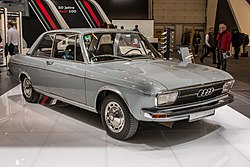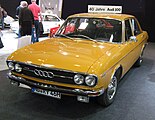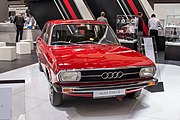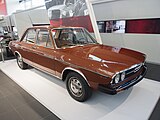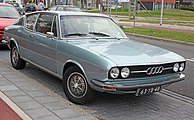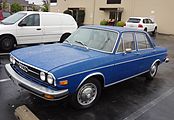Audi 100 C1
| Audi | |
|---|---|
|
Audi 100 (C1)
|
|
| 100 C1 (type F104) | |
| Production period: | 1968-1977 |
| Class : | upper middle class |
| Body versions : | Limousine , coupe |
| Engines: |
Petrol engines : 1.6–1.9 liters (59–85 kW) |
| Length: | 4398-4635 mm |
| Width: | 1729-1750 mm |
| Height: | 1370-1421 mm |
| Wheelbase : | 2560-2675 mm |
| Empty weight : | 1050-1120 kg |
| successor | Audi 100 C2 |
The Audi 100 C1 (type F104 or as Coupé F105) is an upper middle class passenger car from Auto Union GmbH (from 1969: Audi NSU Auto Union AG ) . The vehicle with a longitudinally installed four-cylinder in - line engine and front-wheel drive was built as a four-door sedan from October 1968 , the two-door version followed in October 1969. Production of the Audi 100 Coupé S presented in September 1969 began in July 1970.
While the Audi 100 C1 in Europe was replaced by the successor Audi 100 C2 (Type 43) in the summer of 1976 , production for the North American market continued until March 1977. A total of 827,474 vehicles were built.
Model history
General
The genesis of this car is considered unusual. Essentially, those in charge at Volkswagen in Wolfsburg thought that with the Daimler-Benz subsidiary Auto Union, which was threatened with bankruptcy in the mid-1960s, they had acquired another assembly plant in Ingolstadt for the VW Beetle , which was still selling well . Free capacities there were filled with the assembly of the VW Beetle. The badly selling DKW F102 was revised and equipped with a four-stroke engine. With this car, known internally as the “ Audi F103 ”, the Auto Union brand Audi was born. The chairman of the board, Heinrich Nordhoff , ordered that no new models should be developed in Ingolstadt.
Ludwig Kraus , who worked at Daimler-Benz until 1963 , did not believe in the future of the VW Beetle and developed a new model under the name Audi 100 at Auto Union without the knowledge of the VW Board of Management and mostly after work. Nordhoff was the first to produce the finished car finally presented. With the Audi 100, a computer-calculated body was developed for the first time in the creation of a series vehicle using the finite element method . The plan was to produce a one-off edition of 100,000 vehicles, but demand was so great that 827,474 vehicles had been produced by the end of production.
The secret development of this model was ultimately the reason that Audi was retained as an independent brand. In the early 1970s, Audi's modern and easy-to-sell vehicles saved Volkswagenwerk AG , which was struggling with sales problems . With the Beetle and its derivatives up to the VW 411 with air-cooled rear engine, this was technically sidelined and was only possible by resorting to developments by the group subsidiary Audi NSU ( VW K 70 - 1970 and Audi 80 - 1972, from 1973 also as VW Passat ) able to convert their offer to modern models with water-cooled front engines and front-wheel drive in a short time .
Initially, all cars were equipped with four-cylinder engines with a displacement of 1.8 to 1.9 liters . They were based on the “medium-pressure engine ” of the Audi F103 , which was taken over from Mercedes , a conventional design with side camshaft and bumpers , which ran reliably and economically, but also rough. In 1974 Audi replaced the weakest of the 1760 cc engines with an EA827 engine with 1588 cc and overhead camshaft from the new Audi 80 .
In 1971 the production of the Audi 100 was relocated to Neckarsulm in the former NSU factory.
The pricing of the first-generation Audi 100 was quite unusual: from its launch in October 1969 to January 1972, the two-door sedan was just as expensive as the four-door. Occasionally contemporary authors remarked that “the sedan with two doors already looks like an elegant coupé”; The design effort for the two-door model with particularly large doors and large rear side panels was also unusually high, which could explain the pricing policy.
Facelift
As early as October 1969, eleven months after the presentation, the Audi 100 LS received a more powerful carburetor at the same time as the start of production of the two-door sedan, which was also installed in duplicate in the new Audi 100 Coupé S (type F105) from October 1970. From April 1970 the Audi 100 LS was optionally available with a three-speed automatic transmission from VW for an additional charge of 1200 D-Marks.
In August / September 1971 (for the 1972 model year), all sedans received a flap over the fuel filler cap in the rear right-hand side section and the engine and equipment program was reorganized. The new base engine was the 1.8-liter engine with 85 hp (63 kW) at 5100 rpm with a compression ratio of 8.5: 1 for regular gasoline. For a surcharge, it could be combined with the better LS equipment. Audi replaced the regular petrol engine of the Audi 100 with 80 PS (59 kW) at 5000 rpm with a compression ratio of 9.1: 1 and the premium petrol engine of the Audi 100 S with 90 PS (66 kW) at 5500 rpm Minute with a compression of 10.2: 1. In the still available engine with 100 PS (74 kW) at 5500 revolutions per minute of the Audi 100 LS for premium gasoline, the compression has been reduced for a quieter and smoother engine run. The new top model among sedans was the Audi 100 GL with the same 1.9 liter engine as in the 100 Coupé S; Due to a reduced compression (10.0: 1 instead of 10.2: 1), however, the output fell from 115 PS (85 kW) at 5500 revolutions per minute to 112 PS (82 kW) at 5800 revolutions per minute. The Audi 100 GL received the radiator grille with twin headlights that was already familiar from the Coupé as standard. Like the Coupé, it could now be equipped with the three-speed automatic transmission for a surcharge. In addition, for the first time a power steering appropriate to the vehicle class was available for all models for an additional charge of 725 D-Marks.
In September 1973, the entire series underwent several changes for the 1974 model year: The front section was redesigned, the fenders and bonnet were made more angular and all models were given a plastic radiator grille. Only minor changes were made to the rear of the sedans, most noticeable are the new, horizontally divided rear lights; the rear of the coupe remained unchanged. The rear suspension was also changed: spring-damper units with coil springs replaced the transverse spring bar. In addition, all models were fitted with an interval wipe and seat belts as standard (automatic belts with headrests on the GL and Coupé S). A central connector for the VAG diagnostic system introduced in mid-1971 was installed in the engine compartment .
The model series underwent the last major changes in August / September 1974 for the 1975 model year: The front disc brakes were previously on the inside of the gearbox / differential, where they could easily become oily; Audi moved them out to the usual position on the wheels. However, their diameter had to be reduced from 280 (291 for the top models) to 257 millimeters. The two circles of the brake hydraulics were divided diagonally instead of a front and a rear circle. All versions also got wider rims of the size 5J × 14, which until then were reserved for the 1.9-liter models. At the same time, like the Audi 80, the Audi 100 received a negative scrub radius. Since the new floating caliper disc brakes required more space, new, more bulky wheel disks with smaller hubcaps were required. For the 1975 model year, the sedans also received modified bumpers with black plastic caps on the sides.
At the same time, Audi replaced the basic engine: the weakest version of the 1.8-liter OHV engine was replaced by the nominally equally powerful 1.6-liter EA-827 engine, as it was already in the Audi 80; here it could be combined with the simple L and the higher-quality LS equipment. However, it had a lower torque, was hardly more economical due to a higher speed level and was not available with power steering.
Also in the 1975 model year, the standard steering wheel gearshift was no longer available on the 1.8-liter models;
In 1976 there was a test vehicle fleet for purely electric vehicles called EEP (Audi with RWE and Varta). "The battery-electric electric experiment car 100 (C1) was manufactured at the time to test various accumulators, which could be recharged via a" coupling device "(socket) near the front (US) bumper."
List prices ex works in November 1973 (two-door cars):
- Audi 100 (85 PS) 11,050 DM (based on today's purchasing power: 16,800 euros)
- Audi 100 LS (100 PS) 11,735 DM (17,800 euros)
- Audi 100 GL (112 hp) 12,700 DM (19,300 euros)
- Audi 100 Coupé S (112 hp) 15,090 DM (22,900 euros)
Surcharge for four-door sedan: 375 DM (600 euros)
Model variants
- Audi 100 (1760 cm³, 80, later 85 PS, a downdraft carburetor )
- Audi 100 S (1760 cm³, 90 PS, a downdraft register carburetor , premium gasoline )
- Audi 100 L (from October 1974; 1577 cm³, 85 PS, a downdraft register carburetor Solex 32/35 DIDTA)
- Audi 100 LS (1760 cm³, 85 PS with a downdraft carburetor Solex 35 PDSIT-5, 100 PS with a downdraft register carburetor Solex 32/35 TDID; from January 1976: 1577 cm³, 85 PS, a downdraft register carburetor Zenith 2 B 2)
- Audi 100 GL (from August 1971; 1871 cm³, 112 PS, a downdraft register carburetor Solex 32/35 TDID, double headlights)
- Audi 100 Coupé S (1871 cm³, 115 PS with two downdraft register carburetors Solex 32/35 TDID, from autumn 1971 with 112 PS and one carburetor Solex 32/35 TDID)
- Special bodies
- Audi 100 LS Cabriolet ( Karmann / Osnabrück)
- Audi 100 LS Cabriolet ( Karl Deutsch / Cologne)
- Audi 100 Convertible ( Crayford Engineering )
- Audi 100 LS Estate Kombi ( Crayford Engineering )
Technical specifications
| model | 100 (L) (until August 1974) |
100 S 100 LS |
100 GL 100 Coupé S. |
100 L (from September 1974) |
|---|---|---|---|---|
| engine |
water-cooled four-cylinder four-stroke in-line engine , inclined to the right longitudinally mounted five bearings crankshaft , pressure lubrication below camshaft via Duplex - timing chain driven, bumpers , rocker arms 100 L from September 1974: overhead camshaft via toothed belt driven tappets |
|||
| Mixture generation | A downdraft carburetor with an automatic starter |
A downdraft register carburetor with automatic start |
Two a downdraft carburetor with automatic choke |
A downdraft register carburetor with an automatic starter |
| Displacement | 1760 cc | 1871 cm³ | 1588 cc | |
| Bore × stroke | 81.5 x 84.4 mm | 84 x 84.4 mm | 79.5 x 80.0 mm | |
|
Max. Output kW (PS) at 1 / min |
59 (80) / 5000 63 (85) / 5100 b |
66 (90) / 5000 74 (100) / 5100 b |
82 (112) / 5800 85 (115) / 5800 c |
63 (85) / 5800 |
| transmission |
Front - wheel drive , fully synchronized four-speed manual transmission behind the front axle, steering wheel gearshift , a. W. Middle shift (standard on Coupé S and GL, from October 1974 all models), from August 1970 with 100/112 hp engine: a. W. three-speed automatic transmission with hydraulic converter |
|||
| Front axle |
Double wishbones , spring / damper units with coil springs, anti-roll bar, disc brakes (internally ventilated on Coupé S), internal on all models up to August 1974 |
|||
| Rear axle |
Torsional crank axle : Rigid axle on support levers, Panhard rod for lateral guidance, until August 1973: torsion bar springs , from September 1973: coil springs, hydraulic telescopic shock absorbers , drum brakes |
|||
| Dimensions | Length: 4610 mm (100 LS / GL: 4636 mm, Coupé S: 4400 mm) Width: 1728 mm (100 LS / GL: 1730 mm, Coupé S: 1750 mm) Height: 1414 mm (100 LS / GL: 1422 mm , Coupé S: 1341 mm) Empty weight: 1050 kg (100 LS / GL: 1090–1120 kg, Coupé S: 1100/1120 kg) |
|||
| body | Self-supporting sheet steel body, tank capacity 58 liters | |||
| steering | Rack and pinion steering , turning circle 11.1 meters | |||
| wheelbase | two- and four-door sedans: 2675 mm, Coupé S: 2560 mm | |||
Present stock
By using low-quality recycling - sheet of the fabricated from the mid-1970s, products of the Volkswagen Group later discovered to be very susceptible to rust. This was due to a relatively high copper content in the body panel , which led to intergranular corrosion .
On July 1, 1991, 8,216 sedans of the first series of the Audi 100 were still registered with the Federal Motor Transport Authority .
literature
- Christian Steiger, Thomas Wirth: Audi 1965–1975, The decisive years , Heel Verlag GmbH, Königswinter 2004, ISBN 3-89365-445-3 .
- Dieter Korp: Now I'm helping myself , Volume 35: Audi 100, LS / GL, Coupé (until the end of '75), Motorbuch Verlag, Stuttgart
- Dieter Korp: Now I'm helping myself , Volume 51: Audi 100 - all models (from August 1974 to July 1976), Motorbuch Verlag, Stuttgart, ISBN 3-87943-419-0 .
- Cross-section through engine technology, Volume 238: Repair instructions Audi 100, 100 S, 100 LS, 100 GL, 100 Coupé S, (November 1968 to July 1976) , Bucheli publishing house, Zug (Switzerland)
Individual evidence
- ↑ Motor Rundschau issue 15/1969, pp. 686–692
- ↑ Werner Oswald : Deutsche Autos 1945-1975 , 2nd edition Stuttgart 1976, p. 317, ISBN 3-87943-391-7
- ^ Werner Oswald: German cars since 1945 . 1st edition. Motorbuch-Verlag, Stuttgart 1992, ISBN 3-613-01492-0 , p. 754 .
- ↑ Werner Oswald: German Cars 1945-1975 . Motorbuch Verlag Stuttgart. 12th edition 1987, ISBN 3-87943-391-7 , p. 317.
- ↑ Werner Oswald: German Cars 1945-1975 . Motorbuch Verlag Stuttgart. 12th edition 1987, ISBN 3-87943-391-7 , pp. 317 and 319.
- ↑ a b c d Werner Oswald: German Cars 1945–1975 . Motorbuch Verlag Stuttgart. 12th edition 1987, ISBN 3-87943-391-7 , pp. 317 and 319 to 321.
- ↑ Eckermann, Erik: Audi rarities: prototypes and cars that never went into series production . GeraMond, Munich 2015, ISBN 3-86245-716-8 .
- ^ Audi-NSU advertisement in: DM - Deutsche Mark, issue 11 from November 1973, DM-Verlag für Konsument-Publizistik GmbH, Frankfurt / M.
- ^ Purchase advice for youngtimers from the sixties and seventies, MARKT - Classic Cars and Motorcycles, special issue No. 12 (1992), VF Verlagsgesellschaft mbH Mainz
Web links
- Audi 100 on HR television
- Audi 100 Coupé S Club Deutschland e. V. (ACCD)
- AutoBild Klassik Online: "The authorized signatory Mercedes"
- Link catalog on the topic of Audi 80, 90, 100 and 200 models at curlie.org (formerly DMOZ )
